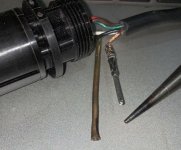rimcanyon
Diamond
- Joined
- Sep 28, 2002
- Location
- Salinas, CA USA
Follow along with the video below to see how to install our site as a web app on your home screen.
Note: This feature may not be available in some browsers.
The pin removal tool will likely be specific to the connector. I suggest you contact Miller.
"Standard pin size"??? I have worked my entire career in electronics and can tell you there is no standard pin size. Even connectors in the same series from the same manufacturer can have different size pins.
Just an example is those ever-popular DA, DB, DC, DD, and DE connectors. There are at least two sizes of plain pins for them and a number of others that include coaxial male and female inserts.
Good sources for the pin extraction tools are the electronic supply houses: Digi-Key, Mouser, Newark, etc. They can help you to ID the connector you have and the tool you need. Most professional connectors will have the OEM's name and perhaps an ID number in the body that holds the pins. Break out a magnifying glass and look.
Those pins look like they have been crimped before insertion. They are almost certainly inserted from the rear. The extraction tool usually, but not always, is used from the front. You could try just rolling up some shim stock and sliding it into the front while tugging at the pin from the rear. An improvised tool like this can also be used from the rear as it can fit over the wire if it is still in the pin. Rear extraction tools will have a slit cylinder construction so they can be slipped over an existing wire.


Thank you all for your suggestions. Gustafson's suggestion to use hobby brass tubing was a good one, but I did not have exactly the right size. So some heat and a finish nail set were applied to bell mouth the tubing to match the inside dia. of the pin hole. Worked great. Tony your comment about the strain relief being the cause of the problem was duly noted. I think you were right. The connection was soldered and the cord was inserted into the plug as far as possible before tightening the clamp. Remote is working.
View attachment 347365
View attachment 347366
YUP ^^^
And I will add, don't bother making a tool, you need to order new pins anyways, so get the pins & the tool at the same time.
Notice
This website or its third-party tools process personal data (e.g. browsing data or IP addresses) and use cookies or other identifiers, which are necessary for its functioning and required to achieve the purposes illustrated in the cookie policy. To learn more, please refer to the cookie policy. In case of sale of your personal information, you may opt out by sending us an email via our Contact Us page. To find out more about the categories of personal information collected and the purposes for which such information will be used, please refer to our privacy policy. You accept the use of cookies or other identifiers by closing or dismissing this notice, by scrolling this page, by clicking a link or button or by continuing to browse otherwise.
